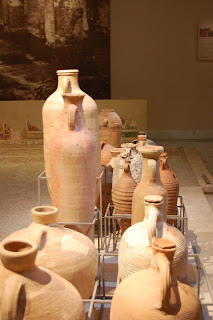


After walking through the 6m thick walls, you have entered the Church of Agios Georgios, or the Rotonda of Galerius. It was built in 306 (4th century A.D.) and survived many of Thessaloniki’s earthquakes; including the earthquake in 1978 that damaged the structure. It has since been under construction and has been subsequently restored; it is currently being stabilized with scaffolding and has been since 2004. The diameter and height of the Rotonda are approximately 30m high and the walls are interrupted by eight rectangular bays. There are only a three mosaics that remain on the arches of the eight bays. One of the bays is the entrance into the cylindrical building and another is an extension, the minaret that was added in 1590.








The building functioned as a church for over 1.200 years until the city fell to the Ottomans. In 1590, it was then converted into a Muslim mosque, the Mosque of Suleyman Hortaji Effendi. It remained a mosque until 1912, when the Greeks captured the city during the Balkan War. It was then formally re-consecrated into a church, but the minaret was not demolished. The building is now a historical monument under the Ephorate of Byzantine Antiquities of the Greek Ministry of Culture, though the Greek Orthodox Church tries to reclaim it every so often.
The Museum of Byzantine Culture aims in presenting various aspects of life during the byzantine and post-byzantine periods: art, ideology, social structure and religion, as well as how historical changes and the political situation were affecting people’s everyday life. The treasures housed in this fine museum include priceless icons, frescoes, sculpted reliefs, mosaics, jewelry, manuscripts, and pottery.


This is a column that was found inside St. Demetrius's Church after the fire in 1917.
"Most of the elaborate decoration inside St. Demetrius's -sculptures, mosaics, and frescoes - was destroyed by the disastrous fire of 1917. However, some interesting parts of the original dcoration do still survive. The lost wall mosaics from the small north colonnade are known from photographs and form the water-colours painted by the English architect W.S. George"

"Fan-shaped ambo from the basilica near the Philippi Museum, 6th century."

Pottery used for food storage and transportation. These were also used as urns in tombs.



Glazed Pottery
"In the Middle Byzantine period, the practice of glazing household wares, particularly tableware, became widespread. A layer of glaze rendered the surface of the pottery impermeable and accentuated the decoration, which was painted, sgraffito (engraved through a layer of white slip), or relief (produced with a mold or a stamp).
The decorative motifs of Middle Byzantine pottery frequently include such mythical creatures as griffins, harpies, and centours, and scenes featuring heroes of the Acritic ballads."

"Vases - used for storage of foods, cooking oils, perfumes, and other liquids"

Tunic worn by priests/pastors/bishops/etc.


Another tunic. This one weighed 50 lbs.


"Scenes from the Old Testament story of Joseph, 1677-82"

"Manuscript Gospel, late 13th first half of 14th century.

Jewelry

"Gold bracelets with enamel decoration, 9th - 11th century. Such costly items of jewelry, which were worn by women, reflect the splendour and the luxury of the imperial court and the aristocracy."
No comments:
Post a Comment